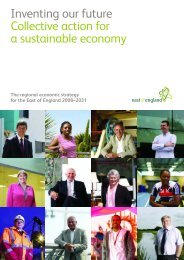Core Strategy Preferred Options document - Amazon Web Services
Core Strategy Preferred Options document - Amazon Web Services
Core Strategy Preferred Options document - Amazon Web Services
Create successful ePaper yourself
Turn your PDF publications into a flip-book with our unique Google optimized e-Paper software.
Strategies, Activities and Actions – Environmental Issues<br />
The Government<br />
defines ‘zero carbon<br />
homes’ as those<br />
where “over a year,<br />
the net carbon<br />
emissions from all<br />
energy use in the<br />
home are zero.”<br />
(Source: Homes for<br />
the future: more<br />
affordable, more<br />
sustainable - Housing<br />
Green Paper, 2007)<br />
Homes which<br />
successfully apply for<br />
a zero carbon home<br />
certificate are exempt<br />
from Stamp Duty<br />
under the Stamp Duty<br />
Land Tax (Zero-<br />
Carbon Homes Relief)<br />
Regulations, 2007.<br />
BREEAM (Building Research Establishment Environmental Assessment<br />
Method) is the world's most widely used environmental assessment<br />
method for buildings. BREEAM covers a wide range of building types<br />
(e.g. BREEAM Offices, BREEAM Retail, BREEAM Industrial), they<br />
assesses these buildings against a set criteria and there are 4 level of<br />
rating (Pass, Good, Very good, Excellent) for all non-domestic<br />
development to achieve.<br />
We will require all non-domestic development to meet the relevant<br />
BREEAM assessment criteria. This is felt to be a more holistic approach<br />
than the Merton Rule, as it covers a wider range of issues other than just<br />
energy use. Whilst the importance of sustainable design is<br />
acknowledged, we do not want to make development unviable through<br />
the imposition of overly onerous standards. As such, whilst a BREEAM<br />
rating of excellent will be encouraged, a rating of at least ‘good’ will be<br />
required.<br />
ENV8 Code for Sustainable Homes – <strong>Preferred</strong> Option<br />
For all new domestic developments, we will ensure that there are real<br />
improvements in key areas such as carbon dioxide emissions and<br />
water use. Development will be required to reach a code level 3 (see<br />
Annex 4) of the Code for Sustainable Homes for all new homes by<br />
2010 and eventually code level 6 by 2013.<br />
ENV8 – Alternative <strong>Options</strong><br />
Option Why is it not preferred?<br />
We will require a higher<br />
level of the Sustainable<br />
Code for Homes to be met<br />
by 2010.<br />
We will require only the<br />
entry level of the<br />
Sustainable Code for<br />
Homes to be met.<br />
ENV9 BREEAM – <strong>Preferred</strong> Option<br />
We will require new non-domestic buildings, as a minimum, to meet<br />
the BREEAM rating of ‘Very good’. We will encourage developers to<br />
attain a BREEAM rating of ‘Excellent’ in all non-domestic<br />
developments.<br />
62<br />
There is a possibility that this<br />
standard would undermine<br />
deliverability.<br />
This would not meet the need for<br />
more sustainable housing to be<br />
developed.
















